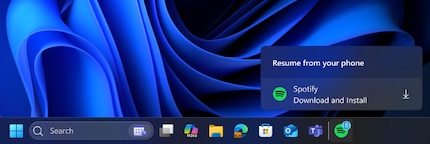
News + Trends
Dark Mode in Windows 11: More bright spots disappear
by Martin Jud

One click and the content switches from your smartphone to your PC: whether it's music, articles or mail, Windows 11 will soon be a seamless addition to your Android mobile phone.
Microsoft is currently testing a function in Windows 11 that allows you to synchronise Android apps with their Windows counterparts on your PC. If you start an app on your smartphone, a notification will appear on your Windows computer with the option to continue exactly where you left off. The test is currently running with Spotify, with more apps to follow.
The function is based on the connection via Phone Link. As soon as you start a song or podcast in Spotify, the smartphone sends a signal to Windows. A «Resume from your phone» message will then appear on your PC. If you click on «Continue on this PC», the Spotify desktop app will open and continue playing at the exact point where you left off. If the app is not yet installed, Windows will take you directly to the Microsoft Store.

In contrast to the previous «Windows Subsystem for Android», Windows does not emulate an Android environment. Instead, the system uses so-called «deep links» to open the appropriate Windows app or an installation process.
The concept is reminiscent of Apple's Handoff function: there, too, you can switch effortlessly between iPhone and Mac. With «Cross-Device Resume», Microsoft wants to create a similar seamless transition - this time between Android smartphone and Windows PC.
The function will be rolled out gradually in the Insider Programme, both in the Dev and Beta channels. Spotify is currently the only app that is officially supported. Microsoft had already briefly demonstrated the feature at the Build conference in May, but later removed the scene from the official video. Apparently, the technology was not yet fully developed.

In the future, «Cross-Device Resume» could cover many more scenarios: for example, resuming an article, an email or a document. For this to work, developers need to build the function into their apps. For you, this means that as long as only a few suppliers join in, the feature will remain limited.
Data protection and setup also play a role. Your smartphone must be permanently linked to the PC, background rights and account synchronisation must be correct. Only once these hurdles have been overcome will the technology realise its potential.
Back in 2016, Microsoft presented a similar function for Windows 10 under the project name «Project Rome». At the time, however, the response from developers was muted. With the new attempt, Microsoft now seems more determined - and technically more mature.
My interests are varied, I just like to enjoy life. Always on the lookout for news about darts, gaming, films and series.